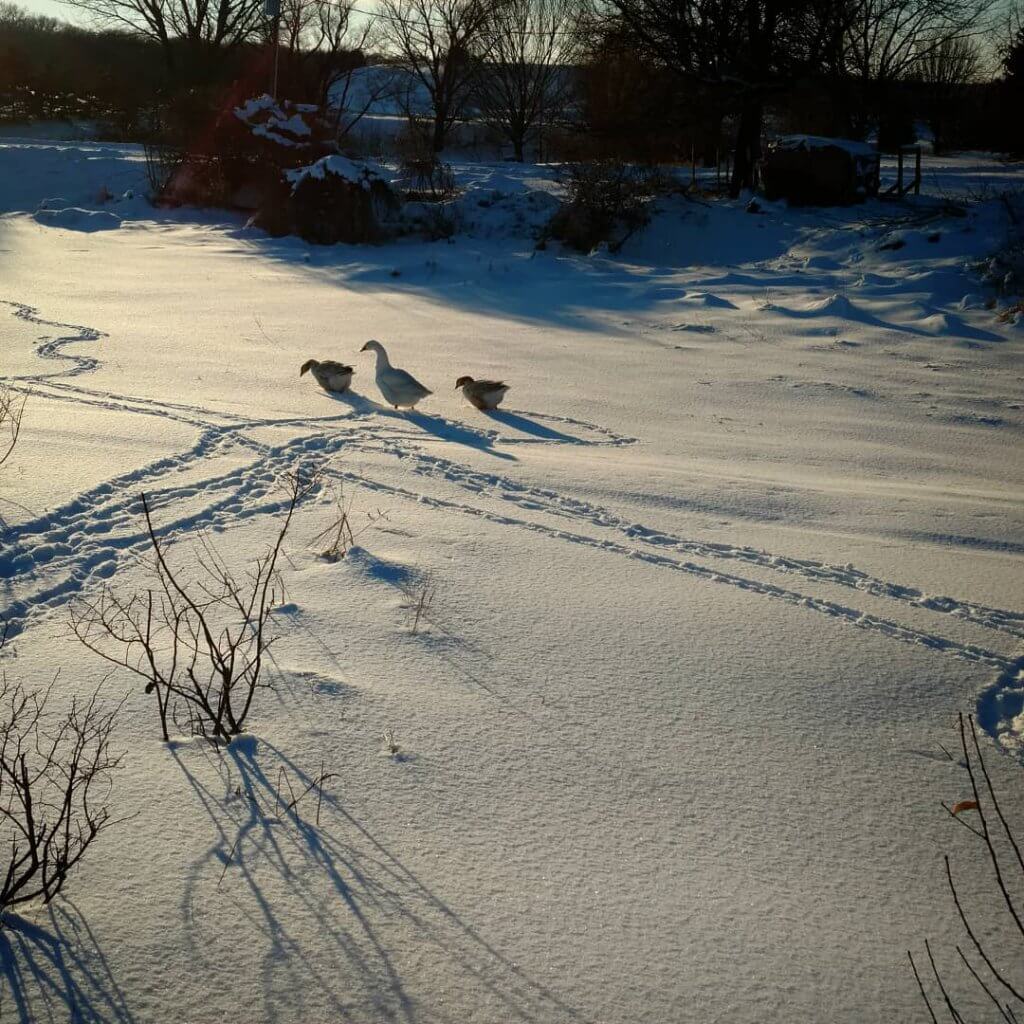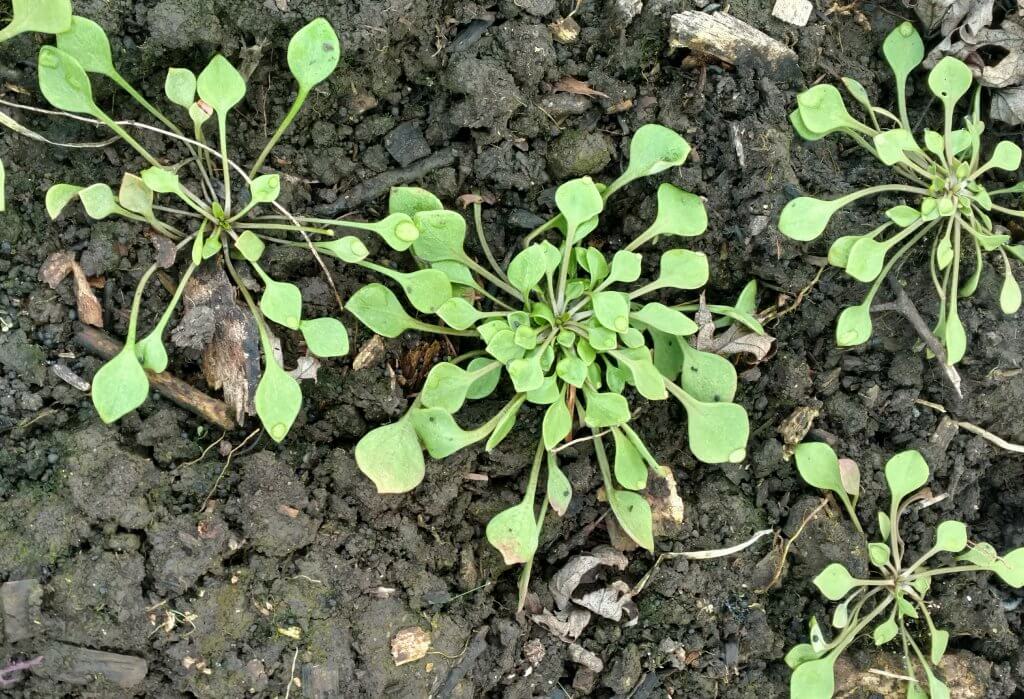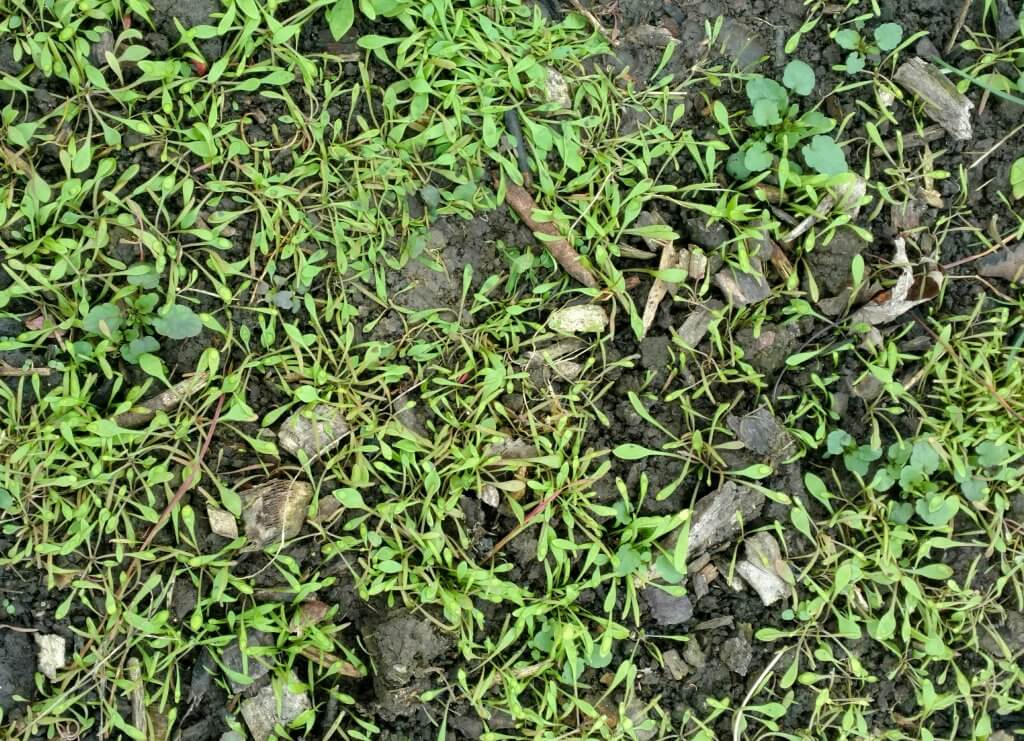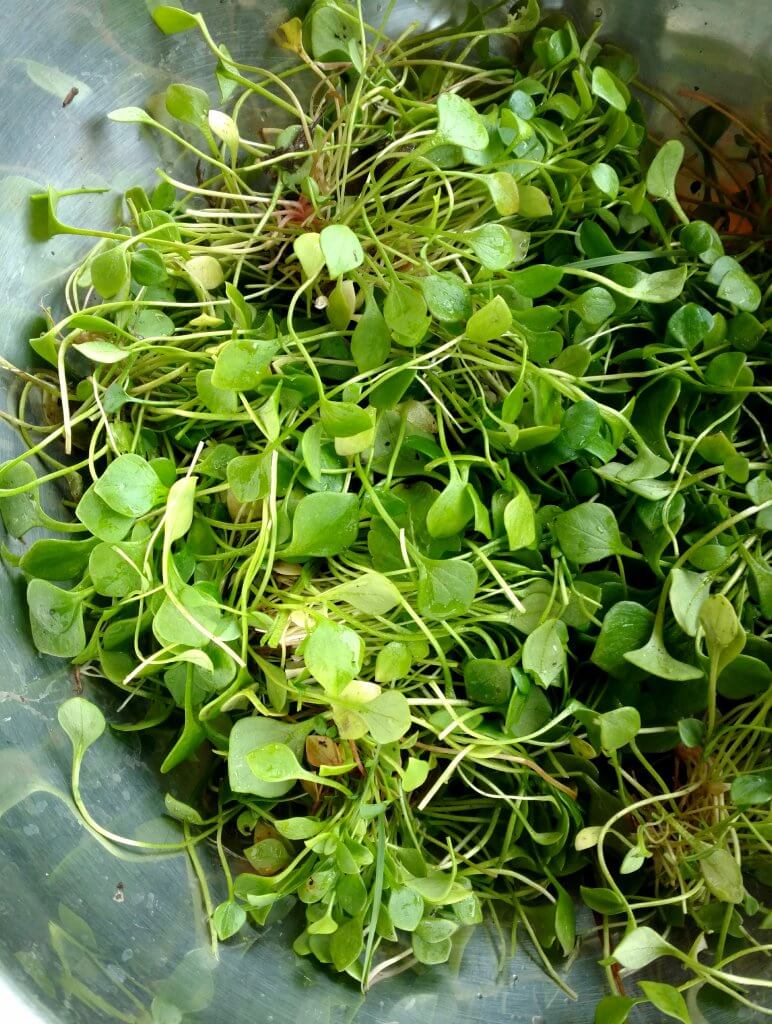Miner’s Lettuce: how to grow it, and what to do with it once you’ve got it!

Petunia, Charles, and Hyacinth making pretty lines of tracks in the snow. They are creative like that, and they don’t let the snow stop them from getting in their daily walks!
Whenever there is enough sunshine to warm it up a little, I slip out to my hoop house to get my itchy fingers into the soil. Even just a thirty-minute session boosts my spirits. “What do you do out there?” asks little/not so little anymore Mack, when I come back into the house. He imagines, I suppose, that I’m stretched out in a hammock, watching old movies or reading new novels. Cozy under a well-worn quilt. (That. Would. Be. Okay.)
But no, even better. I am doing one of three things: 1. I’m harvesting restaurant orders, 2. I’m planting, tending, and fussing over my little plants, or 3. I am managing my ever-expanding crop of miner’s lettuce (also called claytonia).
In my third year of growing miner’s lettuce, I’ve concluded that it is a great little plant, especially for those of us sustainable-living folks who want to grow as much of our own food as possible.
But here’s the thing. If it bugs you when plants drop lots of tiny seeds and then, the next season, they come back like weeds, growing miner’s lettuce (also called claytonia) may not be ideal for you.
For myself, I planted miner’s lettuce (also called, oh, you know) in my hoop house because I had a feeling that it would grow well in this unheated space–grow very slowly, that is–even through the winter. Yes, you read that right. It will grow in a protected, unheated space, all through the winter months, even here in Nebraska where winter is no joke, baby. I sell a bit of it to chefs in the city. They love it. A bit of it. Not bushels, however, which is a shame because that’s what I currently have.
Bushels of claytonia. Bushels and bushels and bushels.
Personally, I love to look at it. It’s very pretty stuff.

See? Pretty, pretty, pretty!!
*cue open-mouthed stare from gentle reader*. . . You love to look at it, Amy? Yes, I know. Isn’t that silly? It hit me the other day, too. Why am I contenting myself to just look at my crop of miner’s lettuce, and not actually harvest and eat this gorgeous stuff myself?
Good question, gentle and astute reader. Good. Question. How we do think alike.
I was harvesting dainty clumps of this succulent green for chefs, and also pulling up clumps that were infringing upon my pansy bed. As I already mentioned, miner’s lettuce is a very enthusiastic plant.

See all the baby claytonia plants? Guess what. This is a bed planted with small pansy plants. They are growing. But not as quickly as the claytonia volunteers. I’ll let the volunteers get a little bigger, then I’ll pull them up and eat them!
In fact, miner’s lettuce is a plant that I learned about from Elliot, my (secret) crush, who, incidentally, just turned 80 this year. We’ve actually never met; we are both happily married (to other people); we live thousands of miles apart, but that doesn’t keep me from crushing on him. He’s just my kinda guy, what can I say?? (Please don’t read this post–in retrospect–honey! Bryan.)
I learned about other cold-hardy crops from Elliot, too, crops that I had never heard the names of before but now grow every year, through the winter: mache, minatina, arugula, mizuna, tatsoi.
This book of his (I’ve shared it with you before) turned my life around, gardening-wise, nearly thirty years ago:
(four-season garden)
This one is awesome, too:
(I just discovered Elliot on IG, too, and he has a gorgeous feed, as you might expect, including many crush-worthy photos of his cute self!)
Of course this one is a staple in my gardening library, too:
Three quick items to take care of, and then we’ll get to the yummiest miner’s lettuce salad recipe you can imagine.
First, I want to thank my long-time (secret) friend Elliot, first, for introducing me to miner’s lettuce. And so many other things, too.
Second, I want to share with you:
How to have miner’s lettuce this year: It’s as easy as falling off a log. Easier, actually. Sow a few seeds where you’d like the lettuce to grow. Keep it damp until it germinates and sprouts, which will be in its own sweet time. OR (better still) start the seeds inside, in a pot or plug tray, and then transplant the baby plants, which–trust me–are adorable. Depending on where you live, you will have to protect them a little, or not. Here in Zone 5, I have it growing in my hoop house, under hoops and plastic. That means I’ve got two layers of protection above it: the hoop house, and the plastic thrown over the smaller hoops inside. I pull the plastic aside, of course, when the sun is shining and the hoop house warms up.
If you don’t have a hoop house, you could attain the two levels of protection another way. A cold frame with a sheet of clear plastic thrown over it at night, for example. Or low hoops with two layers of plastic. So many ways to do this. Straw bales with a heavy window or a superfluous glass door leftover from a remodeling project (we have a couple around here if you want to borrow one). If you live in a warmer clime, only one layer might be necessary.
Of course, there are areas of the world where miner’s lettuce grows wild, and folks can just forage it to their heart’s delight. No sowing. No protective hoops or plastic. Lucky folks! But not everybody can live where the weather is always fine, right? Of course right.
. . . and Third . . .
How to have miner’s lettuce for the rest of your natural life: if you let the little miner’s lettuce plants grow to maturity, that is, to blossom out and go to seed (sometime in the spring), and then also allow them to drop their seeds (frankly, it’s hard to stop them) you will never, EVER lack for miner’s lettuce again. Ever, ever.
Also. You will be filled with delight when you see the little plants grow, even through the winter. It seems like a miracle, when you live in a part of the world where GREEN is not the natural color of the outdoors, but WHITE. Or GRAY. Or a lovely combination of the two.

And it’s as succulent and delicious as it looks!
I was, frankly, astonished (and a little alarmed!) at the number of little plants that came up–all on their own tiny independent little selves!–in my hoophouse this year. I have pulled quite a few, but since I’ve learned how great it is to make salads of it, I don’t mind this a bit. Grow, little babies, grow! I croon to the enthusiastic baby plants. And then I pull them up by the roots, clean them up, and add them to my salads. YUM.
I hope that doesn’t sound cruel.
If I feel like getting a little fancy and making an entire salad of miner’s lettuce, instead of just tossing them into my daily green salad, here’s what I do: (It’s soooo good!)
Miner’s Lettuce (also called claytonia, she interrupted, one more time) Salad
Miner’s lettuce is a delicious wild salad green in some parts of the world, and in other parts (including my part) can be grown through the colder months. It has a crisp, fresh, mild flavor. This salad, made with seeds, cheese, homemade vinaigrette, and dried cranberries really allows it to shine with contrasting shapes, flavors, and colors. It’s crave-worthy. It will make you happy.
Best yet: it will use up a lot of your miner’s lettuce.
It’s so simple:
First, make the vinaigrette dressing:
- 2 cups minced scallions, both green and white parts
- 1/4 cup minced fresh ginger root
- 1/2 cup red or rice wine vinegar
- 1/2 cup Extra virgin olive oil
- Fine sea salt and freshly-ground pepper, to taste
Directions: Mix first three ingredients in blender, then turn on blender and slowly pour in the olive oil. Taste and adjust vinegar/oil ratio, and season with salt and pepper to taste.
Ingredients for the salad (enough for four generous salads):
4 large handfuls of fresh miner’s lettuce
1/4 cup blue cheese crumbles
1/4 cup dried cranberries
1/4 cup salted sunflower seeds, or another favorite nut or seed, toasted
1 Tb chia seeds (optional, but so good for you!)
Lemon zest or orange zest for garnish
Here’s how to make very pretty salads out of all this:
1. Lightly toast the seeds or nuts in a dry pan on the stove top. As soon as they start to develop a light to medium brown color on the sides and smell nutty, they’re done. Careful! Toasting nuts is risky business. Set aside to cool.
2. Arrange the miner’s lettuce on pretty plates and sprinkle on the dried cranberries.
3. Crumble the blue cheese and sprinkle on top.
4. Drizzle small amounts of the vinaigrette on to the plate and miner’s lettuce.
5. Using a Microplane or citrus grater, grate a little lemon or orange zest over the top of the salad to finish.
Serve and prepare yourself for compliments!
Share this post with your friends who also may need a great idea for what to do with all that miner’s lettuce!
Thanks for popping in, gentle reader. And don’t despair. Spring is coming. It is.
*hugs*
- Creamy caper and herby salad dressing: it has staying power
- 11 Sanity-Saving Tips for February & a seed giveaway tease!





Hey – I have a deal for you. How about you bring me 8 oz of Miner’s Lettuce – er, Claytonia – next time we get together and I’ll bring you a pound of small kale, mustard, mizuna, arugula, endive, escarole, chard, dill and/or red veined sorrel in any combination you would like.
I’ve tasted your Miner’s Lettuce before but only a small handful or two.
If your gentle readers wonder how this plant got its name I offer this from Wikipedia:
“The common name of “miner’s lettuce” refers to how the plant was used by California Gold Rush miners, who ate it to prevent scurvy. It can be eaten as a leaf vegetable. Most commonly, it is eaten raw in salads, but it is not quite as delicate as actual lettuce that is cultivated. Sometimes it is boiled like spinach, which it resembles in taste and chemical composition.”
Oh, that’s great, Gene. Thanks for that definition! I actually had intended to add something to that effect to this post, and you’ve done it for me. And–it’s a deal on the greens-swap. I’ll bring you some asap!
Yes! How I love tasty plants that rush to grow everywhere, then leap to be eaten!
I shall plant some forthwith. Thanks for another fun post!
Thank you for your nice comment, Janet! You’ll only have to plant it once . . !
Will grab some seeds and check out the books from the library! Great post! Had me grinning & smiling!
Oh, good. Have fun planting, Rose!
Awesome. Thanks. Will do this recipe post haste. Have miners lettuce everywhere on the grounds. Wondered if the chickens would like it and they love it. Then wondered if I could eat it and yes.
It’s a wonderful crop, especially when it comes up all on its own!
I am near Seattle, where it grows as an invasive! I put some in a planter one year, and the following year it was in every one! I am thinking of throwing a bunch of seed on top of my determinate early potatoes that don’t need hilling. It will be dying back in July, just in time for spuds! In the future it will be ground cover that will prep my bed for summer crops, or easily pulled for spring. Wish me luck!
Wow! i can’t quite even imagine this diminutive lettuce being an invasive plant! But then, we here in Nebraska have punishing winters that prevent many plants from taking root (literally) for too long. Indeed, good luck!! I’d love to hear back about your experiment. I love any sort of companion planting investigations!